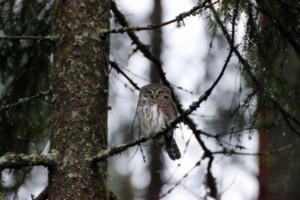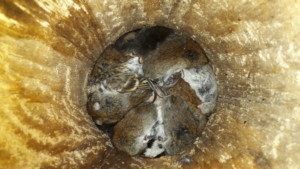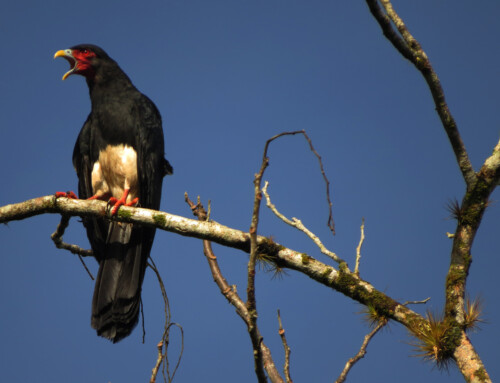LINKED PAPER
Climate change and perishable food hoards of an avian predator: Is the freezer still working? Masoero, G., Laaksonen, T., Morosinotto, C. & Korpimäki, E. 2020. Global Change Biology. DOI: 10.1111/gcb.15250. VIEW
In recent years, large‐scale climatic changes, largely of anthropogenic origin, have been causing disruptions in numerous species, by affecting distribution patterns, population abundance, phenological processes and behaviours. In particular, it is known that changing climate can modify predator–prey interactions and induce declines or local extinctions of species due to reductions in food availability. Animals that hoard perishable food to cope with harsh wintering conditions, like predators, are predicted to be especially susceptible to climate change (Sutton et al. 2016) due to the increasing temperatures and precipitations.
To understand how autumn and winter weather conditions can affect food‐hoarding behaviour, we analysed data on the food hoarding of a generalist predator, the Eurasian Pygmy Owl (Glaucidium passerinum), across 16 years in Finland. The data were collected by Erkki Korpimäki and his research team since 2003 in the vicinity of the towns of Kauhava and Lapua, South Ostrobothnia.

Figure 1 Pygmy Owl © Giulia Masoero
The Pygmy Owl is a small avian predator that feeds on small mammals, especially voles which are their main prey, and birds. They start hoarding for winter usually in late October when the temperature drops below 0° C. They cache large quantities of highly perishable food in tree cavities or nest boxes (“freezers”) to facilitate overwinter survival. Pygmy Owls have been shown to be particularly susceptible to weather variations (Halonen et al. 2007, Terraube et al. 2017).
The food stores may be located in multiple nest boxes some kilometres apart. Female owls that are larger than males as well as young owls accumulate larger food stores than males and adult owls.
My previous studies on the food‐hoarding behaviour of Pygmy Owls have shown that it varies in relation to the availability of main prey species (i.e. abundance of the voles of the genera Myodes and Microtus) and age and sex of the individual (Masoero et al. 2018, 2020), with increasing food hoards in years of vole abundance, in yearling individuals and in females. However, it has not been yet examined how weather conditions, together with main prey abundance and individual traits, can affect the phenology of hoarding or the accumulation, consumption and perishability of the food items.
In this recently published research, we show in details how weather can influence the food-storing behaviour of Pygmy Owls. In particular, we found that fewer freeze–thaw events in early autumn delayed the initiation of food hoarding. Pygmy Owls also consumed more hoarded food with more frequent freeze–thaw events and deeper snow cover in autumn and in winter, and lower precipitation in winter.
Our most interesting results concern the rotting of the food hoards. We discovered that the rotting of food hoards increased with precipitation in autumn and that hoards already present in early autumn were much more likely to rot than the ones initiated in late autumn. Rotten food hoards were used more in years of low food abundance than in years of high food abundance. Having rotten food hoards in autumn resulted in a lower future recapture probability of female owls. This result indicates that either the use of the rotten low-quality food and/or the energy waste linked with collecting a large food store that will not be used can lead to lower survival or to dispersal from the study area.
Figure 2 Food hoard of a Pygmy Owl in a nest-box © Giulia Masoero
In several northern areas, autumns have already become warmer and winters milder and rainy. Predictions show that climate change will likely continue along this path and the length of winter will strongly decrease. Long‐term trends and future predictions, therefore, suggest that impacts of climate change on wintering food‐hoarding species could be substantial, because their ‘freezers’ may no longer work properly.
Our results indicate that Pygmy Owls might be partly able to adapt to climate change by delaying food hoarding. Nonetheless changes in the temperatures, frequency of freeze–thaw events, precipitation and snow cover might impair their foraging and ultimately decrease local overwinter survival. The hoarding behaviour is therefore highly susceptible to global warming because the weather during autumn and winter can affect the condition and usability of the food stores.
As a general conclusion we can say that altered usability and poorer quality of hoarded food may further modify the foraging needs of food‐hoarding predators and thus their overall predation pressure on prey species. This raises concerns about the impacts of climate change on boreal food webs, in which ecological interactions have evolved under cold winter conditions.
Video 1 Climate change and perishable food hoards of an avian predator
References
Halonen, M., Mappes, T., Meri, T., & Suhonen, J. 2007. Influence of snow cover on food hoarding in Pygmy Owls Glaucidium passerinum. Ornis Fennica 84: 105– 111. VIEW
Masoero, G., Morosinotto, C., Laaksonen, T., & Korpimäki, E. 2018. Food hoarding of an avian predator: Sex‐ and age‐related differences under fluctuating food conditions. Behavioral Ecology and Sociobiology 72: 159. VIEW
Masoero, G., Laaksonen, T., Morosinotto, C., & Korpimäki, E. 2020. Age and sex differences in numerical responses, dietary shifts, and total responses of a generalist predator to population dynamics of main prey. Oecologia 192: 699– 711. VIEW
Sutton, A. O., Strickland, D., & Norris, D. R. 2016. Food storage in a changing world: Implications of climate change for food‐caching species. Climate Change Responses 3: 12. VIEW
Terraube, J., Villers, A., Poudré, L., Varjonen, R., & Korpimäki, E. 2017. Increased autumn rainfall disrupts predator‐prey interactions in fragmented boreal forests. Global Change Biology 23: 1361– 1373. VIEW
Image credit
Featured image: Eurasian Pygmy Owl, Glaucidium passerinum | Erik Karits | Pixabay





